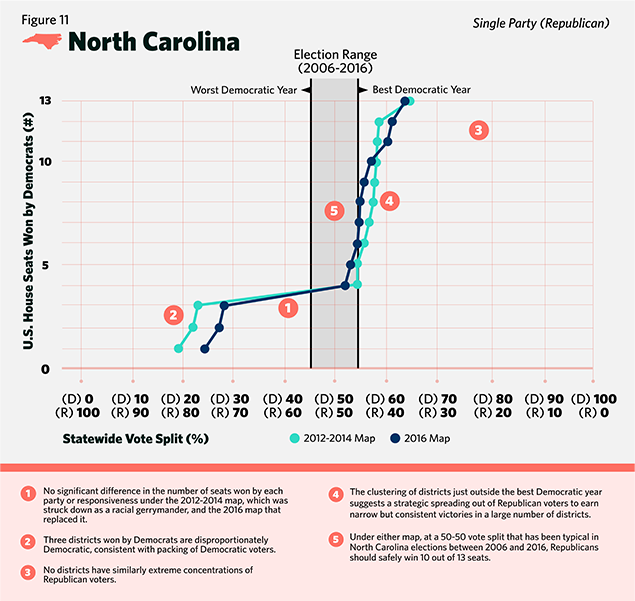North Carolina voters will go to the polls this November for the fourth election in a row using a congressional map that a court has declared unconstitutional. But, depending on what the Supreme Court does when it hears a challenge to the North Carolina map next year, a fairer map still might be possible for 2020.
How bad is the North Carolina map?
In a word: bad.
North Carolina’s 2016 congressional map — which was drawn to replace an earlier map struck down as an unconstitutional racial gerrymander — easily ranks as one of the most aggressive gerrymanders of the decade.
A Brennan Center study found that under multiple measures of bias, the North Carolina map consistently gives Republicans two to three additional seats in Congress in a state that is among the most competitive in the nation at a statewide level. Although the 2016 map is a slight improvement over the earlier racially gerrymandered one, it still bears many of the hallmarks of aggressive gerrymandering.

When will maps be redrawn?
At the parties’ urging, it now looks like the redrawing of the congressional map will not take place until sometime in 2019, meaning that North Carolina voters will use the current map for at least one more election cycle.
The three-judge panel had initially left open the possibility that the map might be redrawn for the 2018 election, with the state perhaps holding special elections in November with runoffs in January. However, the plaintiffs told the court that they had reluctantly concluded that it was too close to Election Day to redraw the map without risking significant voter confusion, and on reflection, the court agreed.
What remains undecided is when, and by whom, the map will be redrawn. The plaintiffs told the court in two filings (here and here) that they preferred to give the Supreme Court a chance to rule in the case before the map is redrawn. However, in a separate joint filing, the plaintiffs told the court that the court should appoint a special master to redraw the map. Although the normal practice in redistricting cases is for a legislature to be given the first opportunity to redraw a map found to be unconstitutional, the plaintiffs said that the North Carolina Legislature’s “repeated and defiant failures to comply with the law disentitle it to one more chance.”
The court is expected to rule on process for redrawing the map sometime this week.
What happens next with the appeal at the Supreme Court?
With the decision not to redraw the map for 2018, all focus now shifts to the Supreme Court, where the expectation is that the appeal of the ruling striking down the map will proceed on a slightly expedited basis.
The legislative defendants have said that they will file their opening position statement by October 1. The plaintiffs then will have until November 1 to respond, after which the Supreme Court will decide whether to set the case for oral argument. If, as expected, the Justices agree to hear the case, argument could be as early as February. A decision, however, is not expected until June 2019.
In any event, stay tuned for the big return of partisan gerrymandering to the Supreme Court.
(Image: Shutterstock)

